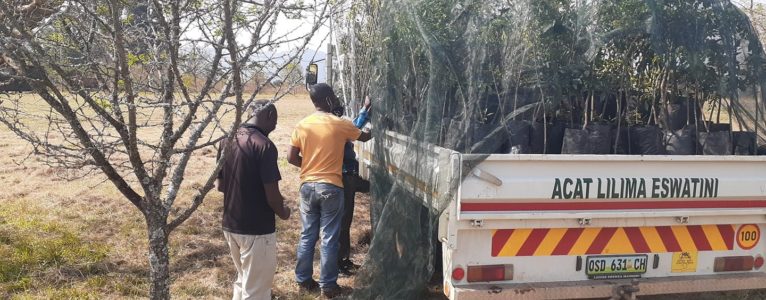In August Eswatini experienced the first seasonal rains thus prompting the scheduled SNPAS tree planting activities to commence in all 7 communities namely Luzelweni, KaZulu, Mhlumeni, KaNdinda, Shewula, Velezizweni, and Emvembili.
This tree planting initiative which will see 3000 indigenous trees being planted, is being conducted as part of the Strengthening Protected Area Systems (SNPAS) project of the Eswatini National Trust Commission (ENTC) funded by the Global Environment Facility (GEF), the United Nations Development Programme (UNDP) and the Government of Eswatini.
The tree-planting activities are being carried out on the ground by four of the network member organizations, namely Green Living Movement, Tenvelo, Eswatini Conference of Churches, and Eswatini Homeopathy Project.
All 4 organizations have attested to the fact that communities have welcomed the project and added their appreciation at being given the opportunity to reintroduce indigenous tree species, some of which have become very scarce in their communities.
The department of forestry under the Ministry of Tourism and Environmental Affairs provided essential training for the NGOs and communities that will be carrying out the tree planting activities and a Forester was assigned to each of the 7 communities to provide training and technical support. This was done to ensure that the trees are planted in such a way that their survival rate will be high and that the communities are made aware of the importance of preserving their indigenous forests. Some of the many trees are (umneyi), (Mkhiwa), (Umnyamatsi), (Umkhakhu), (Umhlume), (Umuwane), Forest Waterberry, (Umntulwa) among a few.
Tree Planting Manual developed for the country
Another success story that came from the partnership between PELUM, SNPAS and the Forestry Department is that an Indigenous Tree Planting Manual was developed and published. Dlamini added that the training manual is aimed at providing a standard guideline for planting indigenous trees and that a soft copy was available for download on the PELUM website www.pelum.org.sz.
Why you should plant indigenous trees
The 2030 Sustainable Development Goal 15 is set to ‘protect, restore and promote sustainable use of terrestrial ecosystems, sustainably manage forests, combat desertification, and halt and reverse land degradation and halt biodiversity loss,’ which is why tree planting is an important activity and calls for the involvement of citizens, particularly rural people who rely on these indigenous forests for their livelihoods. If you are considering joining the tree movement, here are a few benefits you should consider:
- When native plants are propagated, they help local wildlife live and thrive by providing them with a source of food and shelter.
- Indigenous trees perform ecological functions such as absorbing airborne pollutants and reducing soil erosion.
- Indigenous trees can provide medicinal properties that can be of benefit to humans that use them sustainably.
- Climate change mitigation as indigenous trees is more effective at converting carbon dioxide into oxygen, a process known as carbon sequestration.
- Reintroducing threatened species so that future generations can also have access to them.
- Tree planting activities help in creating awareness of the importance of biodiversity.
- Indigenous tree planting helps to re-establish the original eco-system of the region.


